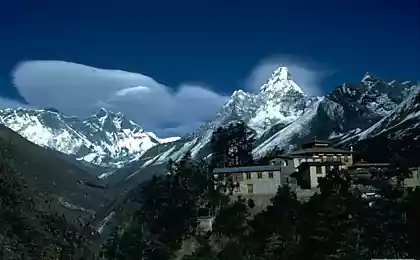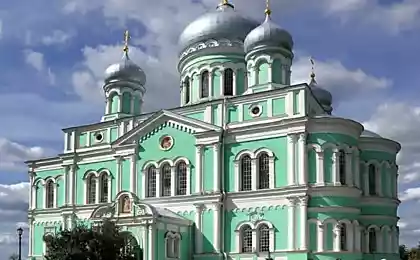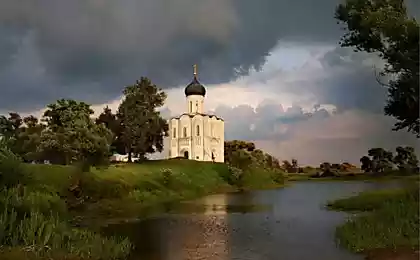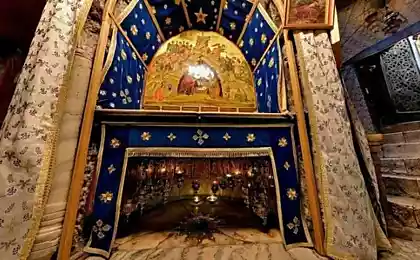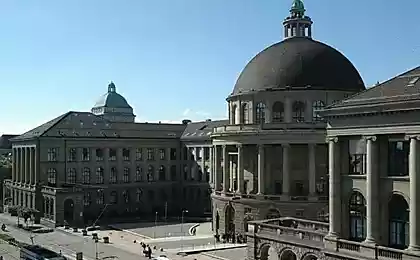717
TOP 10 most beautiful Orthodox monasteries in the world. Part 2
Part 1 can be read here
The monasteries have always been strongholds of Orthodoxy, bastions of spirituality. With the construction of the monastery began the existence of the city, in ancient times they were being Chronicles and developed science.
Orthodox monks supported by starving in the years of crop failure, cared for the sick and, most importantly, always stood at the forefront of spiritual warfare, praying to God for the whole world, for each of us.
Many architectural ensembles of monasteries evolved over the centuries, and acquired such a unique charm that was included in the world heritage List of UNESCO.
Present to the readers the second five of the 10 most beautiful monastic cloisters, which without exaggeration can be called the pearls of the Orthodox world:
1. New Jerusalem monastery
Voskresensky new Jerusalem male monastery, located in Istra of Moscow region, has always been Patriarchal stavropegic (had direct subordination to the Patriarch).
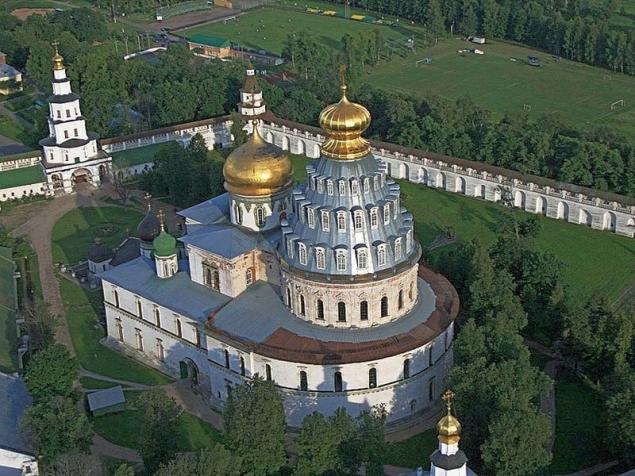
The monastery was founded by Patriarch Nikon in 1656. It was originally conceived as an attempt to transfer on the Russian soil shrines of the Holy Land that has ever made it original and stand out amongst other Russian monasteries.
The surroundings of the future monastery underwent redevelopment: the forest on the Bank of the river Istra, renamed on the site of the monastery in the Jordan were cut down, the hill on which was erected the monastery, dospan and fortified (it became known as Zion). The former name was changed to the new ones taken from the new Testament.
To the East of Zion was situated the hill of olives mount of olives with the stone chapel, to the North, hill Tabor. On the banks of the river Istra was built skete of Patriarch, which was placed in two churches of the Epiphany and of the apostles Peter and Paul. Nearby was also founded by a small convent of Bethany.
Some of the buildings repeat the outlines of the buildings of Jerusalem. For example, the resurrection Cathedral (1656-1685), created in the image and likeness of the Holy Sepulchre.
2. Pochayiv Lavra (Ukraine)
The largest Orthodox monastery in Western Ukraine, according to legend, was founded by monks of Kiev-Pechersk Lavra, who fled from the Tatar invasion in 1240, although his first recorded reference dates back to 1527. The heyday of the monastery falls on the first half of the XVII century-related activity in the region of St. job of Pochaev (aka Abbot John Iron, 1550-1651).
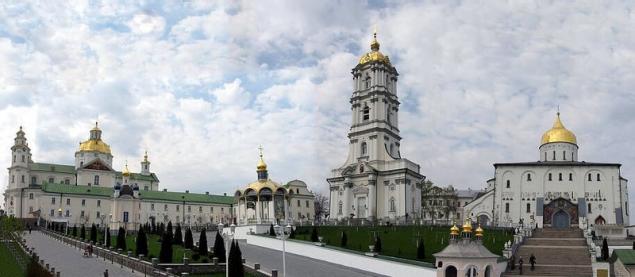
The monk job entered in the monastery a monastic Charter. When it started active construction activity: there was built a new monastery walls, built Holy Trinity Cathedral, and then six more churches. Monk job was created at the monastery of Pochaev printing press and contributed much to the education of the people of Ukraine.
C 1713 in 1831 Pochaev monastery was seized by Greek Catholics. In this period were built the main temple of the Lavra of the Holy Dormition (1771-1791), in the style of "Cossack Baroque", the refectory and cells. But after the suppression of the Polish uprising 1830-1831, by the decree of Emperor Nicholas I, he was returned to the Orthodox.
The most revered shrines of the monastery is a trace of the foot of the Mother of God with the source of healing water, the Miraculous Pochaev icon of the Mother of God, relics of the venerable job of Pochaev and St. Amphilochius of Pochaev.
3. The Royal monastery (Serbia)
Royal Lavra Serbs called Orthodox monastery Zica, located in the vicinity of the historical region of Raska, as here in 1221 was the coronation of the first Serbian king Stefan Prvovencani. Interesting. that crown laid on him the brother of the first Serbian Archbishop Sava (in the world Rastko, Nemanich).
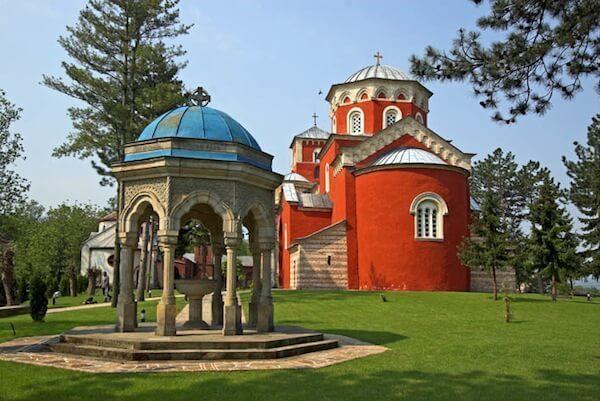
The monastery was founded in the beginning of the XIII century, the future king, and in 1219 the monastery Church of the ascension has been painted especially for this invited Byzantine artists.
Cathedral of the ascension monastery ("Spasov house") became the place of coronations of 19 rulers Serbian (the latter was done at the beginning of the XX century) and the Serbian intronizatsii pieces of the state, so it is always decorated by the best masters, and possessed many relics, which gave the monastery a secular and spiritual ruler.
During the Turkish occupation all the shrines of the monastery were plundered, and the monks persecuted. The restoration of the convent began in 1855 writings of Bishop Uzicko-Grushevskogo of Ioannikes (Neskovic), and in the XX century when king Alexander Karadjordjevic has undergone large-scale restoration.
4. Nilo-Stolobenskaya deserts
Russian monastery, located in the most picturesque places on the island Stolobny and partly on the Peninsula Svetlitsa, 10 kilometers North of the town of Ostashkov, on lake Seliger.

Honor of the founding of the monastery on the island of Stolobny belongs to Reverend Nile Stolobensky, who in 1528 had dug a cave here. At the end of the monk the Nile near his grave on the island began to settle hermits-the prayer book, which eventually merged into a monastery.
Before the revolution the monastery was among the most revered in Russia, every year thousands of people. In the eighteenth century, worked in the monastery the biggest workshop for the manufacture of crosses. At the beginning of the XX century the number of monks reached 1000, the monastery had its own hospital.
The monastery was badly damaged during the Soviet period. Many buildings were destroyed, the shrines defiled. But in 1990, the complex of the Nilo-Stolobenskaya desert was given to the Russian Orthodox Church, and in 1995 the monastery was returned to the relics of the monk Nile.
Restoration of the monastery is not finished, but now its architecture is striking in its beauty. Epiphany Cathedral began to build in 1671, and 300 years were intensively decorated. The silver gates to the Cathedral were cast on sketches by J. M. Kolokolnikov-Voronin.
The ensemble of monastic buildings include the gate Church of the apostles Peter and Paul and the Reverend Nile, a hospital Church in the name of All the Saints, the Church of St. John the Baptist and the virgin Mary, built on the site of the cave of the monastery's founder, and a light and graceful temple Holy cross Church, which stands a little apart from the main monastery complex.
5. Solovetsky monastery
Spaso-Preobrazhensky Stavropegial monastery, located on the Solovetsky Islands in the White sea, often called the "North pearl" of Russia.
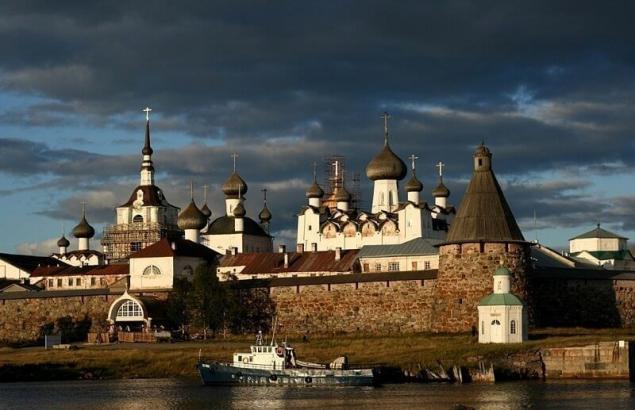
The monastery arose on the Islands in 1436, when it settled the monk Zosima, Herman and Savvatii of Solovetsk, and the stone she built up by the labors of St. Philip (Kolycheva), later Metropolitan of Moscow.
The monastery was one of the largest landowners of the state and the writings of monks, acquired great economy with a system of canals, windmills, greenhouses, a smithy, saltworks, and even his own fleet, and by the XX century there was even a plant. At the same time, the walls of the monastery has long served as a fortress and Outpost of the Russian North.
The buildings of the monastery scattered to the four Islands of the Solovetsky archipelago in the Bay of well-being. The walls of the monastery with seven gates and eight towers, built in the late XVI century by the architect Tryphon from huge stones up to 5 meters, the length of 1084 meters.
The ensemble of the monastery includes: the three-headed Cathedral of the assumption (1552-1557.) with a huge refectory and cellarer chambers, the Transfiguration Cathedral (1558-1566), the five-domed domed cruciform Church on a high basement with pyramidal sloping walls (specially designed to fire in the rebound of the nucleus), the Church of the Annunciation (1596-1601), stone chambers (1615), watermill (early XVII century), bell tower (1777), St. Nicholas Church (1834) and Trinity Church (1856-1859). Many of the buildings are connected by covered walkways.
The Solovetsky monastery was included in the world heritage List of UNESCO.published
Author: Andrew Szeged
Also interesting: Kolomenskoe — the mysterious attraction of the Moscow mount Athos: 30 interesting facts
P. S. And remember, just changing your mind — together we change the world! ©
Join us in Facebook , Vkontakte, Odnoklassniki
Source: sdsmp.ru/smi/2684/
The monasteries have always been strongholds of Orthodoxy, bastions of spirituality. With the construction of the monastery began the existence of the city, in ancient times they were being Chronicles and developed science.
Orthodox monks supported by starving in the years of crop failure, cared for the sick and, most importantly, always stood at the forefront of spiritual warfare, praying to God for the whole world, for each of us.
Many architectural ensembles of monasteries evolved over the centuries, and acquired such a unique charm that was included in the world heritage List of UNESCO.
Present to the readers the second five of the 10 most beautiful monastic cloisters, which without exaggeration can be called the pearls of the Orthodox world:
1. New Jerusalem monastery
Voskresensky new Jerusalem male monastery, located in Istra of Moscow region, has always been Patriarchal stavropegic (had direct subordination to the Patriarch).

The monastery was founded by Patriarch Nikon in 1656. It was originally conceived as an attempt to transfer on the Russian soil shrines of the Holy Land that has ever made it original and stand out amongst other Russian monasteries.
The surroundings of the future monastery underwent redevelopment: the forest on the Bank of the river Istra, renamed on the site of the monastery in the Jordan were cut down, the hill on which was erected the monastery, dospan and fortified (it became known as Zion). The former name was changed to the new ones taken from the new Testament.
To the East of Zion was situated the hill of olives mount of olives with the stone chapel, to the North, hill Tabor. On the banks of the river Istra was built skete of Patriarch, which was placed in two churches of the Epiphany and of the apostles Peter and Paul. Nearby was also founded by a small convent of Bethany.
Some of the buildings repeat the outlines of the buildings of Jerusalem. For example, the resurrection Cathedral (1656-1685), created in the image and likeness of the Holy Sepulchre.
2. Pochayiv Lavra (Ukraine)
The largest Orthodox monastery in Western Ukraine, according to legend, was founded by monks of Kiev-Pechersk Lavra, who fled from the Tatar invasion in 1240, although his first recorded reference dates back to 1527. The heyday of the monastery falls on the first half of the XVII century-related activity in the region of St. job of Pochaev (aka Abbot John Iron, 1550-1651).

The monk job entered in the monastery a monastic Charter. When it started active construction activity: there was built a new monastery walls, built Holy Trinity Cathedral, and then six more churches. Monk job was created at the monastery of Pochaev printing press and contributed much to the education of the people of Ukraine.
C 1713 in 1831 Pochaev monastery was seized by Greek Catholics. In this period were built the main temple of the Lavra of the Holy Dormition (1771-1791), in the style of "Cossack Baroque", the refectory and cells. But after the suppression of the Polish uprising 1830-1831, by the decree of Emperor Nicholas I, he was returned to the Orthodox.
The most revered shrines of the monastery is a trace of the foot of the Mother of God with the source of healing water, the Miraculous Pochaev icon of the Mother of God, relics of the venerable job of Pochaev and St. Amphilochius of Pochaev.
3. The Royal monastery (Serbia)
Royal Lavra Serbs called Orthodox monastery Zica, located in the vicinity of the historical region of Raska, as here in 1221 was the coronation of the first Serbian king Stefan Prvovencani. Interesting. that crown laid on him the brother of the first Serbian Archbishop Sava (in the world Rastko, Nemanich).

The monastery was founded in the beginning of the XIII century, the future king, and in 1219 the monastery Church of the ascension has been painted especially for this invited Byzantine artists.
Cathedral of the ascension monastery ("Spasov house") became the place of coronations of 19 rulers Serbian (the latter was done at the beginning of the XX century) and the Serbian intronizatsii pieces of the state, so it is always decorated by the best masters, and possessed many relics, which gave the monastery a secular and spiritual ruler.
During the Turkish occupation all the shrines of the monastery were plundered, and the monks persecuted. The restoration of the convent began in 1855 writings of Bishop Uzicko-Grushevskogo of Ioannikes (Neskovic), and in the XX century when king Alexander Karadjordjevic has undergone large-scale restoration.
4. Nilo-Stolobenskaya deserts
Russian monastery, located in the most picturesque places on the island Stolobny and partly on the Peninsula Svetlitsa, 10 kilometers North of the town of Ostashkov, on lake Seliger.

Honor of the founding of the monastery on the island of Stolobny belongs to Reverend Nile Stolobensky, who in 1528 had dug a cave here. At the end of the monk the Nile near his grave on the island began to settle hermits-the prayer book, which eventually merged into a monastery.
Before the revolution the monastery was among the most revered in Russia, every year thousands of people. In the eighteenth century, worked in the monastery the biggest workshop for the manufacture of crosses. At the beginning of the XX century the number of monks reached 1000, the monastery had its own hospital.
The monastery was badly damaged during the Soviet period. Many buildings were destroyed, the shrines defiled. But in 1990, the complex of the Nilo-Stolobenskaya desert was given to the Russian Orthodox Church, and in 1995 the monastery was returned to the relics of the monk Nile.
Restoration of the monastery is not finished, but now its architecture is striking in its beauty. Epiphany Cathedral began to build in 1671, and 300 years were intensively decorated. The silver gates to the Cathedral were cast on sketches by J. M. Kolokolnikov-Voronin.
The ensemble of monastic buildings include the gate Church of the apostles Peter and Paul and the Reverend Nile, a hospital Church in the name of All the Saints, the Church of St. John the Baptist and the virgin Mary, built on the site of the cave of the monastery's founder, and a light and graceful temple Holy cross Church, which stands a little apart from the main monastery complex.
5. Solovetsky monastery
Spaso-Preobrazhensky Stavropegial monastery, located on the Solovetsky Islands in the White sea, often called the "North pearl" of Russia.

The monastery arose on the Islands in 1436, when it settled the monk Zosima, Herman and Savvatii of Solovetsk, and the stone she built up by the labors of St. Philip (Kolycheva), later Metropolitan of Moscow.
The monastery was one of the largest landowners of the state and the writings of monks, acquired great economy with a system of canals, windmills, greenhouses, a smithy, saltworks, and even his own fleet, and by the XX century there was even a plant. At the same time, the walls of the monastery has long served as a fortress and Outpost of the Russian North.
The buildings of the monastery scattered to the four Islands of the Solovetsky archipelago in the Bay of well-being. The walls of the monastery with seven gates and eight towers, built in the late XVI century by the architect Tryphon from huge stones up to 5 meters, the length of 1084 meters.
The ensemble of the monastery includes: the three-headed Cathedral of the assumption (1552-1557.) with a huge refectory and cellarer chambers, the Transfiguration Cathedral (1558-1566), the five-domed domed cruciform Church on a high basement with pyramidal sloping walls (specially designed to fire in the rebound of the nucleus), the Church of the Annunciation (1596-1601), stone chambers (1615), watermill (early XVII century), bell tower (1777), St. Nicholas Church (1834) and Trinity Church (1856-1859). Many of the buildings are connected by covered walkways.
The Solovetsky monastery was included in the world heritage List of UNESCO.published
Author: Andrew Szeged
Also interesting: Kolomenskoe — the mysterious attraction of the Moscow mount Athos: 30 interesting facts
P. S. And remember, just changing your mind — together we change the world! ©
Join us in Facebook , Vkontakte, Odnoklassniki
Source: sdsmp.ru/smi/2684/
